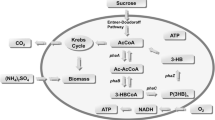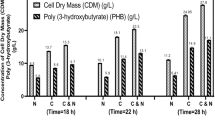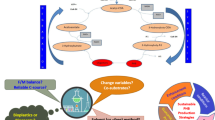Abstract
Polyhydroxyalkanoates (PHAs) are biodegradable polymers which are considered as an effective alternative for conventional plastics due to their mechanical properties similar to the latter. However, the widespread use of these polymers is still hampered due to their higher cost of production as compared to plastics. The production cost could be overcome by obtaining high yields and productivity. The goal of the present research was to enhance the yield of polyhydroxybutyrate (PHB) with the help of two simple fed-batch cultivation strategies. In the present study, average batch kinetic and substrate limitation/inhibition study data of Alcaligenes latus was used for the development of PHB model which was then adopted for designing various off-line nutrient feeding strategies to enhance PHB accumulation. The predictive ability of the model was validated by experimental implementation of two fed-batch strategies. One such dynamic strategy of fed-batch cultivation under pseudo-steady state with respect to nitrogen and simultaneous carbon feeding strategy resulted in significantly high biomass and PHB concentration of 39.17 g/L and 29.64 g/L, respectively. This feeding strategy demonstrated a high PHB productivity and PHB content of 0.6 g/L h and 75%, respectively, which were remarkably high in comparison to batch cultivation. The mathematical model can also be employed for designing various other nutrient feeding strategies.



Similar content being viewed by others
References
Mozumder, M. S. I., Garcia-Gonzalez, L., De Wever, H., & Volcke, E. I. (2016). Model-based process analysis of heterotrophic-autotrophic poly (3-hydroxybutyrate)(PHB) production. Biochemical Engineering Journal, 114, 202–208.
Novak, M., Koller, M., Braunegg, M., & Horvat, P. (2015). Mathematical modelling as a tool for optimized PHA production. Chemical and Biochemical Engineering Quarterly, 29, 183–220.
Chanprateep, S. (2010). Current trends in biodegradable polyhydroxyalkanoates. Journal of Bioscience and Bioengineering, 110, 621–632.
Hafuka, A., Sakaida, K., Satoh, H., Takahashi, M., Watanabe, Y., & Okabe, S. (2011). Effect of feeding regimens on polyhydroxybutyrate production from food wastes by Cupriavidus necator. Bioresource Technology, 102, 3551–3553.
Shen, L., Haufe, J., & Patel, M. K. (2009). Product overview and market projection of emerging bio-based plastics PRO-BIP 2009. Report for European Polysaccharide Network of Excellence (EPNOE) and European Bioplastics, 243.
Kaur, G., & Roy, I. (2015). Strategies for large-scale production of polyhydroxyalkanoates. Chemical and Biochemical Engineering Quarterly, 29, 157–172.
Gahlawat, G., & Srivastava, A. K. (2013). Development of a mathematical model for the growth associated Polyhydroxybutyrate fermentation by Azohydromonas australica and its use for the design of fed-batch cultivation strategies. Bioresource Technology, 137, 98–105.
Dixit, P., Mehta, A., Gahlawat, G., Prasad, G. S., & Choudhury, A. R. (2015). Understanding the effect of interaction among aeration, agitation and impeller positions on mass transfer during pullulan fermentation by Aureobasidium pullulans. RSC Advances, 5(49), 38984–38994.
Khanna, S., & Srivastava, A. K. (2006a). Computer simulated fed-batch cultivation for over production of PHB: a comparison of simultaneous and alternate feeding of carbon and nitrogen. Biochemical Engineering Journal, 27, 197–203.
Zinn, M., Weilenmann, H. U., Hany, R., Schmid, M., & Egli, T. (2003). Tailored synthesis of poly ([R]-3-hydroxybutyrate-co-3-hydroxyvalerate)(PHB/HV) in Ralstonia eutropha DSM 428. Acta Biotechnologica, 23, 309–316.
Mozumder, M. S. I., De Wever, H., Volcke, E. I., & Garcia-Gonzalez, L. (2014). A robust fed-batch feeding strategy independent of the carbon source for optimal polyhydroxybutyrate production. Process Biochemistry, 49, 365–373.
Khanna, S., & Srivastava, A. K. (2006b). Optimization of nutrient feed concentration and addition time for production of poly (β-hydroxybutyrate). Enzyme Microbial Technology, 39(5), 1145–1151.
Patwardhan, P., & Srivastava, A. K. (2008). Fed-batch cultivation of Wautersia eutropha. Bioresource Technology, 99, 1787–1792.
Gahlawat, G., Sengupta, B., & Srivastava, A. K. (2012). Enhanced production of poly(3-hydroxybutyrate) in a novel airlift reactor with in situ cell retention using Azohydromonas australica. Journal of Industrial Microbiology Biotechnology, 39, 1377–1384.
Gahlawat, G., & Srivastava, A. K. (2012). Estimation of fundamental kinetic parameters of polyhydroxybutyrate fermentation process of Azohydromonas australica using statistical approach of media optimization. Applied Biochemistry and Biotechnology, 168, 1051–1064.
Volesky, B., & Votruba, J. (1992). Mathematical model identification. In Modeling and optimization of fermentation process (pp. 38–54). Amsterdam: Elsevier.
Rosenbrock, H. H. (1960). An automatic method of finding the greatest or the least value of a function. Computer Journal, 3, 175–184.
Kaur, G., Srivastava, A. K., & Chand, S. (2012). Mathematical modeling approach for concentration and productivity enhancement of 1,3-propanediol using Clostridium diolis. Biochemical Engineering Journal, 68, 34–41.
Miller, G. L. (1959). Use of dinitrosalicylic acid reagent for determination of reducing sugar. Analytical Chemistry, 31, 426–428.
Horwitz, W. (1980). Official methods of analysis of the Association of Official Analytical Chemist (thirteenth ed.). Washington, DC: AOAC Methods.
Riis, V., & Mai, W. (1988). Gas chromatographic determination of polyβ-hydroxybutyric acid in microbial biomass after hydrochloric acid propanolysis. Journal of Chromatography A, 445, 285–289.
Grothe, E., Moo-Young, M., & Chisti, Y. (1999). Fermentation optimization for the production of poly(β-hydroxybutyric acid) microbial thermoplastic. Enzyme and Microbial Technology, 25, 132–141.
Grothe, E., & Chisti, Y. (2000). Poly (β-hydroxybutyric acid) thermoplastic production by Alcaligenes latus: behavior of fed-batch cultures. Bioprocess Engineering, 22, 441–449.
Loo, C. Y., & Sudesh, K. (2007). Polyhydroxyalkanoates: bio-based microbial plastics and their properties. Malaysian Polymer Journal, 2, 31–57.
Zafar, M., Kumar, S., Kumar, S., & Dhiman, A. K. (2012). Artificial intelligence based modeling and optimization of poly(3-hydroxybutyrate-co-3-hydroxyvalerate) production process by using Azohydromonas lata MTCC 2311 from cane molasses supplemented with volatile fatty acids: a genetic algorithm paradigm. Bioresource Technology, 104, 631–641.
Penloglou, G., Chatzidoukas, C., & Kiparissides, C. (2012). Microbial production of polyhydroxybutyrate with tailor-made properties: an integrated modelling approach and experimental validation. Biotechnology Advances, 30, 329–337.
Chatzidoukas, C., Penloglou, G., & Kiparissides, C. (2013). Development of a structured dynamic model for the production of polyhydroxybutyrate (PHB) in Azohydromonas lata cultures. Biochemical Engineering Journal, 71, 2–80.
Yu, P. H., Chua, H., Huang, A. L., & Ho, K. P. (1999). Conversion of industrial food wastes by Alcaligenes latus into polyhydroxyalkanoates. Applied Biochemistry and Biotechnology, 78, 445–454.
Cavalheiro, J. M. B. T., de Almeida, M. C. M. D., Grandfils, C., & da Fonseca, M. M. R. (2009). Poly(3-hydroxybutyrate) production by Cupriavidus necator using waste glycerol. Process Biochemistry, 44, 509–515.
Ienczak, J., Quines, L., Melo, A. D., Brandellero, M., Mendes, C., Schmidell, W., & Aragão, G. (2011). High cell density strategy for poly (3-hydroxybutyrate) production by Cupriavidus necator. Brazilian Journal of Chemical Engineering, 28, 585–596.
Sayed, E. I., Azhar, A., Abdelhady, H. M., Abdel Hafez, A. M., & Khodair, T. A. (2009). Batch production of polyhydroxybutyrate (PHB) by Ralstonia eutropha and Alcaligenes latus using bioreactor different culture strategies. Journal of Applied Sciences Research, 5, 556–564.
Penloglou, G., Roussos, A., Chatzidoukas, C., & Kiparissides, C. (2010). A combined metabolic/polymerization kinetic model on the microbial production of poly (3-hydroxybutyrate). New Biotechnology, 27, 358–367.
Acknowledgements
The Senior Research Fellowship (SRF) award by the Department of Biotechnology (DBT), Govt. of India, New Delhi, for the execution of the project is gratefully acknowledged by one of the authors (Ms. Geeta Gahlawat).
Author information
Authors and Affiliations
Corresponding author
Rights and permissions
About this article
Cite this article
Gahlawat, G., Srivastava, A.K. Model-Based Nutrient Feeding Strategies for the Increased Production of Polyhydroxybutyrate (PHB) by Alcaligenes latus . Appl Biochem Biotechnol 183, 530–542 (2017). https://doi.org/10.1007/s12010-017-2482-8
Received:
Accepted:
Published:
Issue Date:
DOI: https://doi.org/10.1007/s12010-017-2482-8




